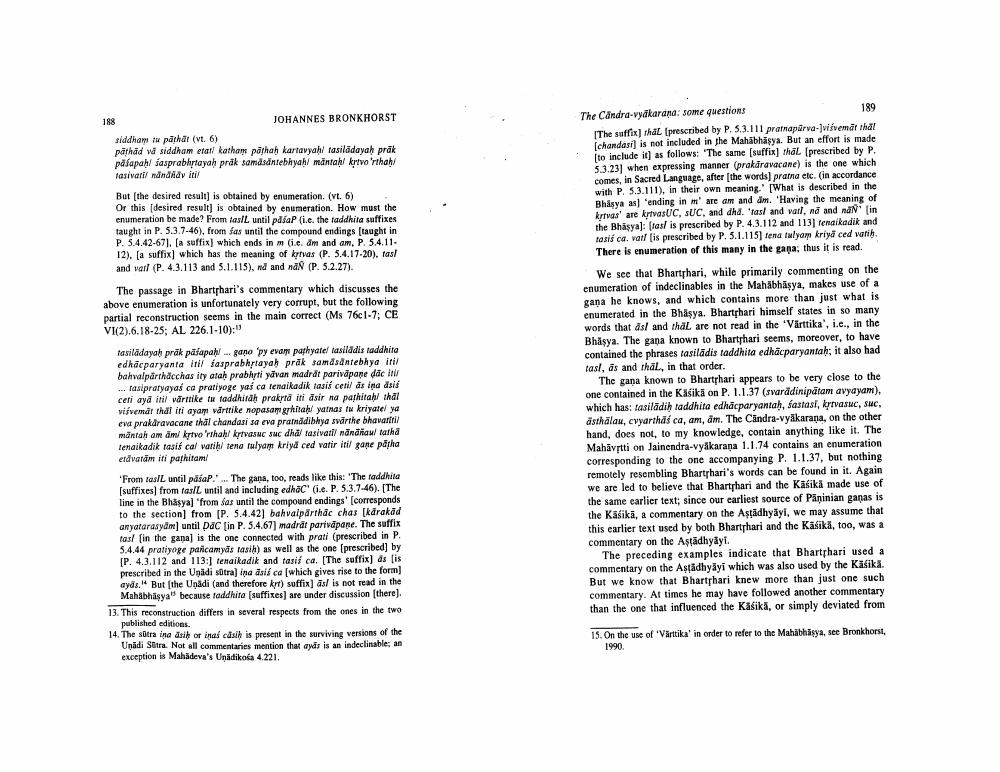Book Title: Candra Vyakarna Some Questions Author(s): Johannes Bronkhorst Publisher: Johannes Bronkhorst View full book textPage 4
________________ JOHANNES BRONKHORST siddham tu pachat (vt. 6) pathad wa siddham etarl katham pashah kartavyah/ tasiladayah prāk påfapah/ sasprabhrlayah prak samdsäntebhyah/ mántahl krivo'rthah/ tasivaril nandaa iti But the desired result) is obtained by enumeration. (vt. 6) Or this [desired result is obtained by enumeration. How must the enumeration be made? From lasit until pdsap (i.c. the faddhita suffixes taught in P. 5.3.7-46), from fas until the compound endings (taught in P. 5.4.42-671. (a suffix) which ends in m (ic. am and am. P. 5.4.11. 12). (a suffix) which has the meaning of krvas (P. 5.4.17-20). tas! and vail (P. 4.3.113 and 5.1.115), nd and nd (P. 5.2.27). The passage in Bharthari's commentary which discusses the above enumeration is unfortunately very corrupt, but the following partial reconstruction seems in the main correct (Ms 76c1-7; CE VI(2).6.18-25; AL 226.1-10): Salah The Candra-vyakarana: some questions 189 The suffix] that (prescribed by P. 5.3.111 pratnapürva-Jvisvemar that Ichandasi] is not included in the Mahabhäsya. But an effort is made to include it) as follows: "The same [suffix thal (prescribed by P. 5.3.23] when expressing manner (prakaravacane) is the one which comes, in Sacred Language, after the words] pratna etc. in accordance with P. 5.3.111), in their own meaning.' (What is described in the Bhåsya as) 'ending in m are am and dim. "Having the meaning of krvas' are krvasUC, SUC, and dha. 'asl and vail, nã and nd in the Bhasya]: (tas/ is prescribed by P. 4.3.112 and 113) renaikadik and tasis ca. vat is prescribed by P. 5.1.115) tena tulyam kriya ced watib. There is enumeration of this many in the gana, thus it is read. We see that Bharthari, while primarily commenting on the enumeration of indeclinables in the Mahabhâsya, makes use of a gana he knows, and which contains more than just what is enumerated in the Bhäşya. Bharthari himself states in so many words that asl and thaL are not read in the 'Varttika', i.c., in the Bhasya. The gana known to Bharthari seems, moreover, to have contained the phrases tasilādis taddhita edhäcparyantah; it also had tasl, as and thāl, in that order. The gana known to Bharthari appears to be very close to the one contained in the Kasika on P. 1.1.37 (svarădinipātam avyayam). which has: tasilādih taddhita edhacparyantah, sastasi, kyrvasuc, suc, ästhälau, cvyarthas ca, am, am. The Candra-vyakarana, on the other hand, does not, to my knowledge, contain anything like it. The Mahavrtti on Jainendra-vyåkarana 1.1.74 contains an enumeration corresponding to the one accompanying P. 1.1.37, but nothing remotely resembling Bharthari's words can be found in it. Again we are led to believe that Bharthari and the Kasikā made use of the same carlier text; since our earliest source of Pāņinian ganas is the Käsikä, a commentary on the Astādhyay, we may assume that this earlier text used by both Bharthari and the Käsikā, too, was a commentary on the Astādhyayi. The preceding examples indicate that Bharthari used a commentary on the Astädhyāyi which was also used by the Käsika. But we know that Bharthari knew more than just one such commentary. At times he may have followed another commentary than the one that influenced the Kasika, or simply deviated from tasiladayah prāk pāfapah...gano 'py evam pathyatel taslladis taddhita edhācparyanta ini fasprabhstayah prāk samasantebhya iris bahwalpárthdcchas ity atah prabhrti yavan madrát pariväpane dac in ... lasipratyayas ca pratiyoge yaś ca tenaikadik tasis cetil as ina asis ceri aya itil varitike tu faddhitah prakta iti asir na pashitah/ thal visvend that iti ayam vārtrike nopasamgrhilah yarnas i kriyatel ya cva prakdravacane thāl chandasi sa eva prainddibhya svarthe bhavartti mäntah amam/ krtvorthah/ krvasnc suc dhaltasivatli nandriau tatha lenaikadik tasis cal vatih tena tulyam kriyd ced vatir itil game parha erdvaram ili parhitam! 'From tasll until pasap.' ... The gana, too, reads like this: "The addhita [suffixes) from fasil until and including edhac' i.e. P. 5.3.7-46). (The line in the Bhasya) 'from Sas until the compound endings' (corresponds to the section] from [P. 5.4.42] bahvalparthāc chas [kärakad anyatarasydn) until Dac [in P. 5.4.67) madrāt pariväpane. The suffix tas/ (in the gana) is the one connected with prati (prescribed in P. 5.4.44 pratiyoge pancamyās tasih) as well as the one (prescribed] by P. 4.3.112 and 113:] tenaikadik and tasis ca. [The suffix) as is prescribed in the Unādi stra) ina asit ca (which gives rise to the form] ayas. But the Unadi (and therefore krt) suffix] asl is not read in the Mahabhäsya" because taddhita (suffixes) are under discussion (there). 13. This reconstruction differs in several respects from the ones in the two published editions. 14. The straina sit or inaf cash is present in the surviving versions of the Unādi Stra. Not all commentaries mention that aws is an indeclinable: an exception is Mahadeva's Unādikosa 4.221. yassi prakrteriala 15. On the use of "Vārttika' in order to refer to the Mahābhāsya, see Bronkhorst, 1990Page Navigation
1 2 3 4 5 6 7 8 9 10
